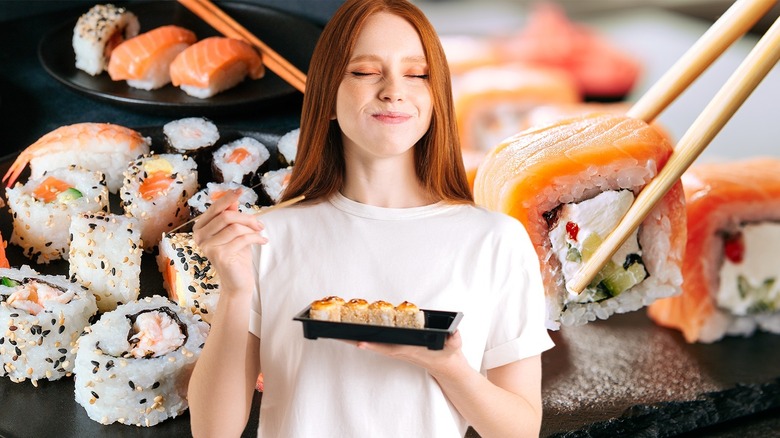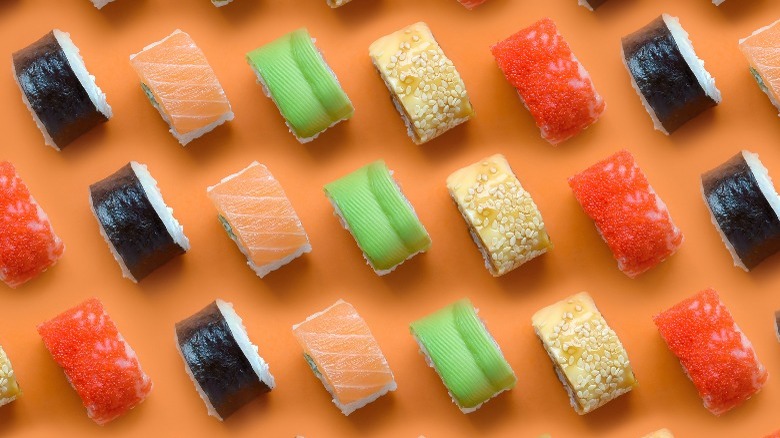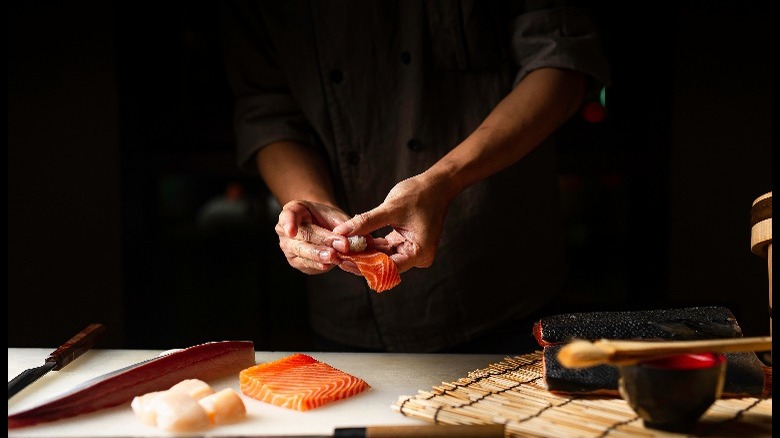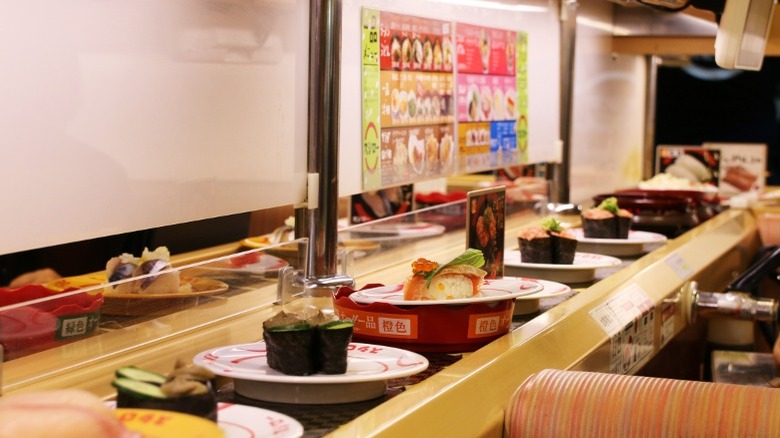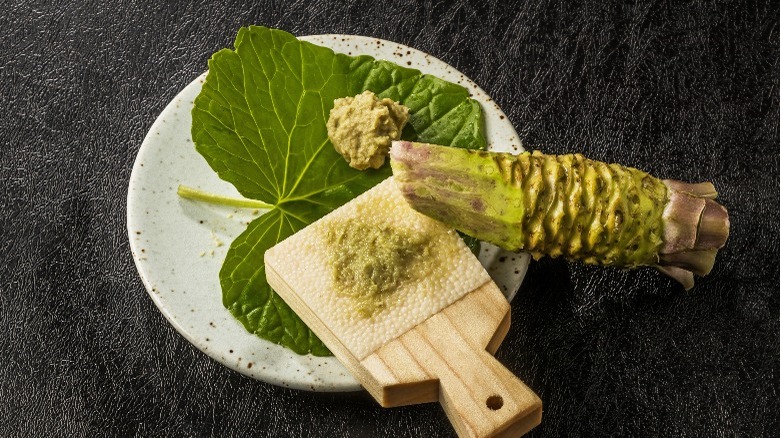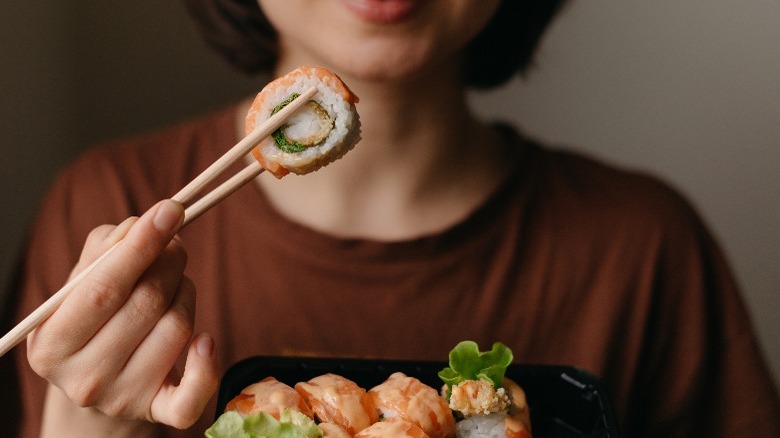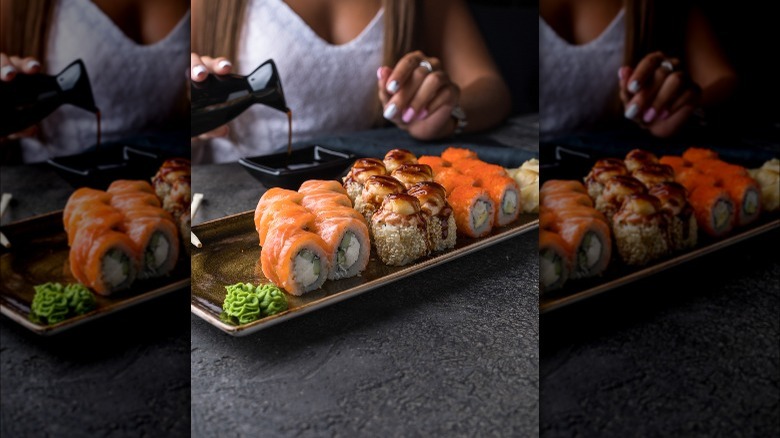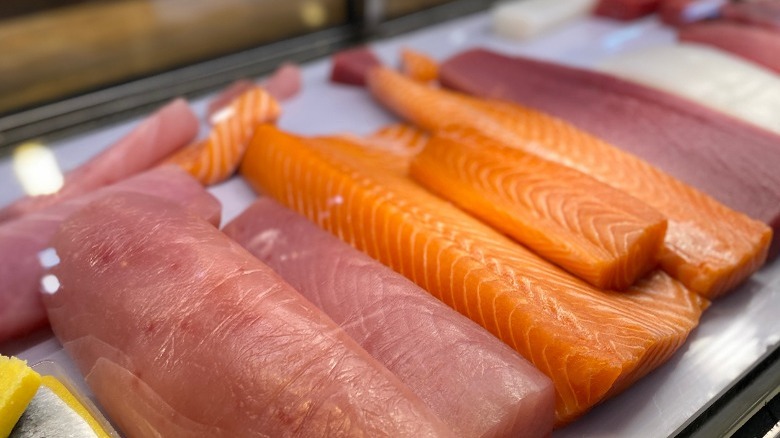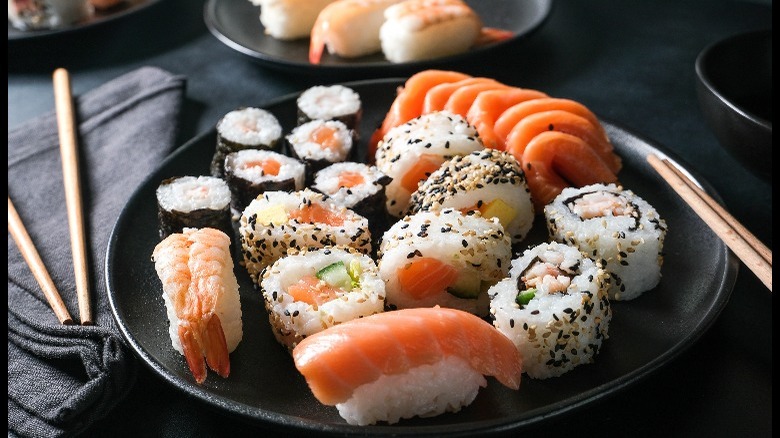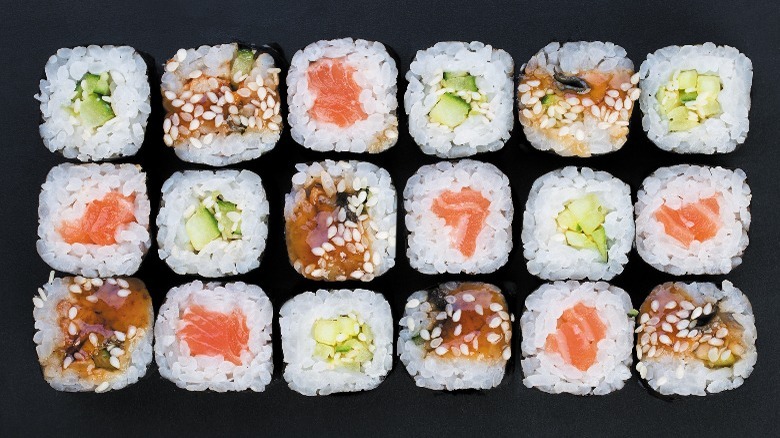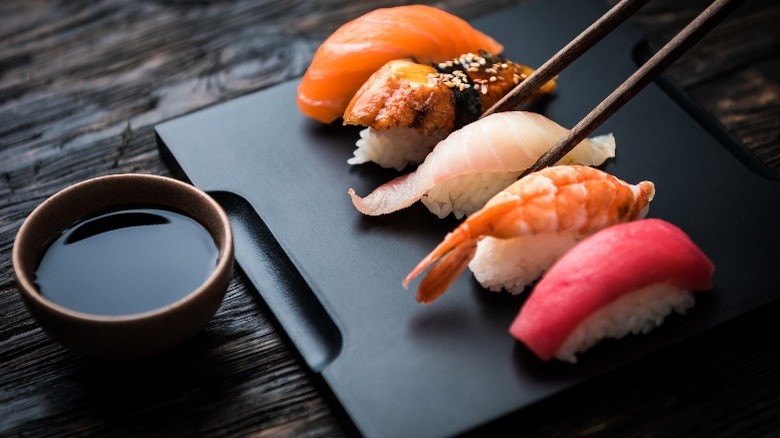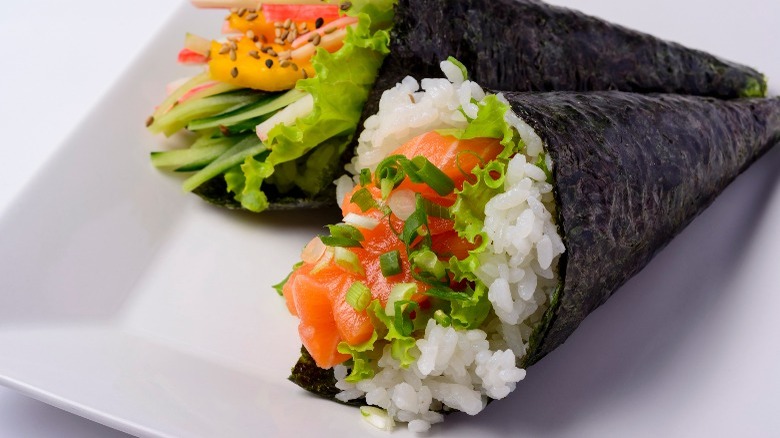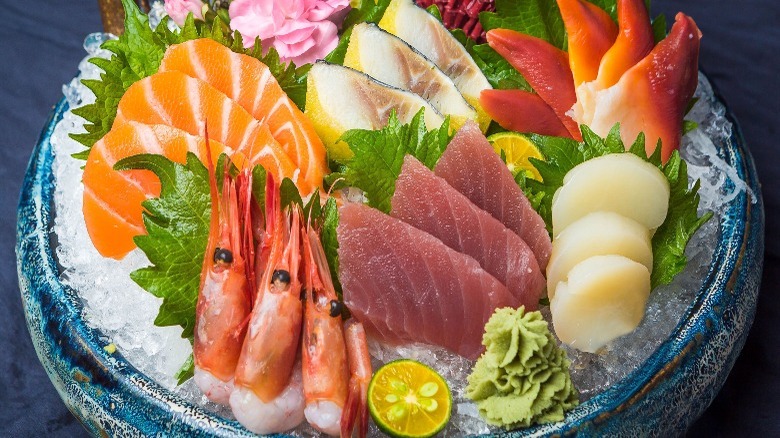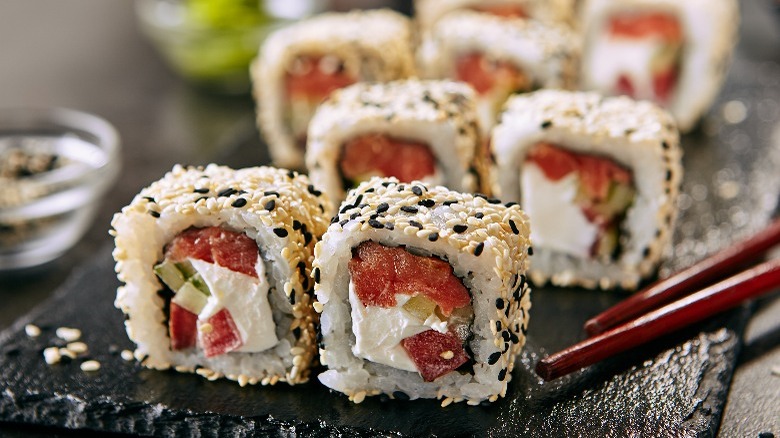A Beginner's Guide To Ordering And Eating Sushi
If you're new to the world of sushi, going to a sushi restaurant for the first time can seem overwhelming. How do you make sense of the menu? What are the different types of sushi rolls? What can you expect when ordering sushi, and how should you eat it? What do you do with the wasabi and pickled ginger? How much soy sauce should you pour into your dish?
Whether you're visiting the home of sushi on a trip to Japan, eating sushi as a guest at somebody's house, or dining out in a sushi restaurant, there's no need to worry. Most people who know a thing or two about sushi will be more than happy to guide you if you're unsure what to do.
For those who want more information, our beginner's guide to ordering and eating sushi explains all you need to know. Armed with this, you'll be practically a sushi expert in no time.
What is sushi?
The word "sushi" means "it's sour" — and that's pretty accurate, as sushi is simply vinegared rice with a variety of different toppings. Sushi always includes rice. Toppings can include raw fish or seafood, though you'll also find vegetable sushi, egg sushi, and meat sushi with chicken or duck, usually in a sauce or marinade.
Special sushi rice known as japonica, a medium-grained white rice, is cooked and then seasoned with vinegar, salt, and sugar. The starchy quality of the rice means it sticks together better than other varieties of long-grained or short-grained rice. You'll often find sushi in the refrigerated section of your local grocery store, but it is traditionally served at room temperature, though some sushi is served colder than others.
Though all sushi incorporates rice, there are several different kinds of sushi. The two primary kinds are nigiri and maki. Nigiri is simply seasoned rice topped with raw seafood or fish, while maki sushi rolls the rice, fish, or other ingredients in a sheet of dried seaweed known as nori. You'll find various different types of maki, too.
Sushi served in Japan differs greatly from what we eat in the U.S. and other Western countries. You'll often see complex sushi with many different toppings in the U.S. In contrast, sushi in Japan is usually very simple, with a single topping of one type of fish, seafood, or vegetable. You also won't generally find avocado in Japanese sushi rolls.
A brief history of sushi
Sushi has been served in Japan for more than a thousand years. Originally, the dish was simply fermented fish with rice preserved in salt. Sushi was served in this way throughout the Edo Period (1603 – 1868) but this fermentation and salting wasn't about flavor — instead, it was simply a way to preserve fish and rice in a time before refrigeration.
Though it's commonly considered to have originated in Japan, sushi actually has its roots in China, where it may have originated from a Chinese dish known as narezushi in the second century B.C. By the seventh century, sushi had arrived in Japan, but it wasn't until the early 17th century that Matsumoto Yoshiichi, the first true sushi chef in Edo (modern-day Tokyo), prepared rice with rice wine vinegar, giving birth to seasoned sushi rice as we know it today.
Nigiri sushi took root in early 19th-century Japan, when Hanaya Yohei began serving fresh fish atop a small portion of rice with seasoning from his street stall in Tokyo. This fast-food snack grew in popularity, spreading throughout Japan.
What to expect when ordering sushi
When ordering sushi in a traditional sushi restaurant or Japanese restaurant, you'll normally order and be served your sushi at your table. The menu will usually divide sushi rolls into specific types, such as maki, nigiri, temaki, or sashimi (slices of raw fish). Many menus include illustrations or photos so you know what to expect from each type of sushi, but don't be afraid to ask. Unless you're dining alone, it's common for platters of sushi rolls to be served, with each diner having their own plate to move the sushi to and eat from.
If you're dining in a restaurant with a revolving conveyor belt of sushi, just help yourself to the dishes you fancy from the belt. Some restaurants will have color-coded plates or stickers to identify the price of dishes. Don't see what you fancy on the conveyor? You can also order the dish you want by asking a member of staff.
On the table you'll usually have chopsticks, a bottle of soy sauce, and a small side dish for your soy sauce. Some establishments serve wasabi (a fiery bright green paste) and pink pickled ginger in dishes on the table, while others will bring it alongside your sushi. It's common to order some side dishes or extras alongside your sushi, such as miso soup, edamame, or salad.
Wondering how much sushi to order per diner? A good rule of thumb is to allow around six to eight rolls for those with average appetites, allowing room for a couple of small sides to share. Diners with bigger appetites may want to order 10 to 14 rolls per person. If you're not sure, it's better to order less to start out with.
Why is sushi served with wasabi and pickled ginger?
You may see some people placing pickled ginger — or "gari," in Japanese –on top of their sushi, but this isn't how you're supposed to enjoy it. This bright pink pickle is actually designed as a palate cleanser to be eaten between sushi rolls. Gari helps you get ready to appreciate the flavors of the next sushi roll.
Pickled ginger is steeped in vinegar and sugar, activating anthocyanin, a color pigment responsible for that pink hue. Sometimes beet juice or red food coloring is added to enhance the color.
The bright green paste next to the pickled ginger is wasabi, or Japanese horseradish. This hot, fiery paste is traditionally made with wasabi rhizomes, but outside Japan, horseradish is often used as a substitute. The smell of wasabi, rather than the flavor, is said to stimulate the taste buds. Make sure to use it sparingly — it's famously hot.
How to eat sushi: All you need to know
Your sushi has arrived, and you're famished. But wait ... How do you eat sushi?
Traditionally, you should start with more delicate flavors first, so if there are any whitefish sushi rolls (such as sea bream) on the table, those are a great place to start. Fattier, richer fish with stronger flavors, such as conger eel or tuna, should be saved for later.
Though you'll often see diners eating sushi with chopsticks, you can also use your hands if this is easier for you. You should try to consume a sushi roll in one bite. Where this isn't possible — for example, with larger rolls — it's acceptable to take two bites, as long as you do so cleanly and try not to let rice fall into your soy dish.
Pour just a little soy into your dish — or onto your plate, if soy sauce dishes haven't been provided. Don't pour too much, as you can always go back for more.
Dip your sushi into the soy sauce seaweed- or fish-side down. Sushi should never be dunked into the soy rice-side down, as this means the rice will absorb lots of soy sauce and become too salty, spoiling the sushi's delicate flavors. Between sushi rolls, take a piece of pickled ginger from the plate with your chopsticks to cleanse your palate.
Should you mix your soy and wasabi?
Pouring too much soy sauce is considered wasteful and poor etiquette in Japan. For this reason, Japanese people don't traditionally mix wasabi into their soy sauce. If you accidentally add too much, the soy sauce is ruined and wasted.
In modern sushi restaurants across the U.S. and Europe, you'll often see diners mixing wasabi with their soy sauce. While it's considered a bit of a dining faux pas to do so, nobody will judge you if that's the way you prefer to eat your sushi. The more traditional way to enjoy wasabi is to add just a little to the top of your sushi roll using your chopsticks.
Wasabi is extremely hot, so don't slather it all over your sushi roll. Start with a pea-sized amount until you see how much your taste buds can tolerate. As is the case for soy sauce, you can always go back for more.
What fish are commonly used in sushi?
Not all fish are suitable for use in sushi. Fish labeled "sushi-grade" has been pretreated by freezing at extremely low temperatures to reduce the risk of foodborne illnesses like salmonella or listeria.
In addition, fish such as tuna, sea bass, and swordfish are high in mercury. Consuming too much mercury can affect your central nervous system, so it's wise to limit your consumption of these fish when ordering sushi.
Among the most common types of fish and seafood used in sushi are sea bass, tuna, mackerel, salmon, trout, eel, squid, scallops, prawns, clams, sea bream, and swordfish. If you're preparing sushi at home, never use fish that isn't labeled as sushi-grade, as parasites in the fish could make you sick.
If you're dining in a Japanese restaurant or at a sushi bar, these establishments will usually have a trusted local sushi-grade fish and seafood supplier, often a nearby fish market. If you're still concerned about the risk of illness from consuming raw fish, you could always order meat or vegetable sushi instead.
Different types of sushi
As we mentioned earlier, there are two main types of sushi — nigiri and maki. Within these two main categories are several variations on sushi rolls, such as temaki. Let's briefly touch on what each type of sushi is.
Maki sushi is the most common sushi you'll find in fast-food restaurants and grocery stores. This type of sushi has a filling encased in rice, wrapped in a dried sheet of nori. There's also uramaki (inside out rolls) where the nori is on the inside and the rice on the outside.
Then there's nigiri. If you've ever seen the oblong blocks of rice topped with a slice of fish (or eggs or meat), that's nigiri. These rolls differ from maki, as there's no nori involved.
Temaki is hand-rolled sushi where various fillings and sushi rice are rolled up like a wrap. This is a great type of sushi for beginners to enjoy.
Finally, there's sashimi. No rice is involved here, so while sashimi technically isn't sushi, you'll generally find it on the menu at sushi restaurants. Sashimi is simply slices of raw food — usually fish.
Makizushi (Maki)
As we've already mentioned, makizushi or maki rolls are the most common rolls you'll find in sushi restaurants and grocery stores. There are actually four types of maki: futomaki, the most common type of cylindrical roll which commonly contains a single filling; uramaki (inside out rolls); temaki, or hand rolls, and hosomaki, where a half sheet of nori is used to create bite-sized pieces.
Maki can be filled with vegetables, fish, seafood, or meat. Some of the most common fillings for maki rolls include spicy tuna, salmon, avocado, cucumber, crabsticks, chopped shrimp, egg, cream cheese, or tobiko (fish roe). Maki is made by spreading seasoned sushi rice on top of a sheet of nori, then adding the fillings and rolling the sheet up before slicing the roll into individual portions. Maki sushi is smaller than uramaki, so if this is the only type of sushi you're ordering, you may need to order a few rolls per person.
Nigiri
Nigirizushi means "hand-pressed sushi" and is commonly called nigiri. This small, oval-shaped block of seasoned sushi rice is molded by hand and topped with a slice of fish. The sticky sushi rice helps hold the topping in place.
The fish used for nigiri is generally raw, with tuna and salmon both being popular choices. Sushi chefs may spread a little wasabi between the fish and rice or top the fish with a garnish or sauce. You can also add your own wasabi between the rice and fish, if this hasn't already been done.
As well as fish, you'll often find seafood such as boiled, butterflied shrimp or grilled eel. Japanese omelets are a common topping for nigiri, too. Sometimes a strip of nori is used to wrap around the nigiri.
You can eat nigiri with your fingers or chopsticks, usually in one bite and, of course, don't overdo it with the soy sauce.
Temaki
Temaki is an excellent type of sushi for those new to the world of sushi. This hand-rolled sushi consists of a sheet of nori topped with sushi rice and the filling(s) of your choice. It's then rolled up by hand into a cone shape (or a regular roll shape).
You can eat temaki with your hands, as you would a wrap, adding as much wasabi as you like and dipping the roll in soy sauce. If you're serving temaki at home, you can prepare a platter of fish, meat, or vegetables, a stack of nori sheets, and a bowl of sushi rice. Guests can then roll their own temaki, choosing the fillings they prefer.
Popular fish for temaki include tuna, salmon, tobiko (flying fish roe), yellowtail, shrimp, and sea bream. A good selection of vegetables includes daikon (radish sprouts), takuan (yellow daikon pickles), carrots, corn, lettuce, avocado, and cucumber.
Don't eat fish, or don't want to eat raw fish? Add cooked ingredients such as shrimp tempura or boiled shrimp, chicken karaage, chicken teriyaki, or chicken katsu, sweet-rolled omelet, tuna mayo, or umeboshi (pickled plum) to your temaki.
Sashimi
Since all types of sushi contain rice, sashimi can't technically be considered sushi. Yet you'll find these thin slices of raw food, typically fish, on the menu at most sushi bars and Japanese restaurants.
Not all sashimi is completely raw. Tako (octopus) sashimi is generally poached, whereas tataki features seared fish dipped in vinegar.
Common fish and seafood used raw for sashimi include sea bream, salmon, tuna, mackerel, greater yellowtail, squid, sweet shrimp, scallops, and surf clam. You'll also find ikura (salmon roe) and uni (sea urchin) at many restaurants. Meat options for sashimi commonly include beef, deer, or horse.
Sashimi is always eaten with chopsticks, and you can dip the fish directly into your soy sauce dish. You'll usually be served wasabi and ground ginger alongside your main course, and you can use chopsticks to dab a little of either or both onto your fish. Most sashimi is cut small enough to be eaten in one bite.
Uramaki (Inside out rolls)
Uramaki rolls are a type of maki roll where the rice is on the outside and the nori on the inside. "Ura" means "back" or "inside" and "maki" means roll, hence you'll often hear uramaki referred to as inside out rolls.
Unlike some other more traditional types of sushi, you'll often find many uramaki rolls have Western flavors and use a range of fillings including meat as well as fish and vegetables. Some of the most popular uramaki on restaurant menus include teriyaki duck and teriyaki chicken uramaki; spicy tuna uramaki; salmon and avocado; and California Rolls filled with avocado, crab (or imitation crab), and cucumber.
The history of the California Roll is quite interesting. Though several chefs have tried to lay claim to inventing this inside out roll, it's generally thought to have been created by Hidekazu Tojo.
While working as the head chef at Jinya restaurant in Vancouver, Tojo decided to create a roll with only ingredients his clientele would enjoy. Part of that involved hiding the seaweed that many patrons wouldn't want to eat, inside the roll, with the rice on the outside. The finished roll originally took its creator's name and became the Tojo Roll, but due to its popularity with patrons from California, it soon gained the name we know today.
